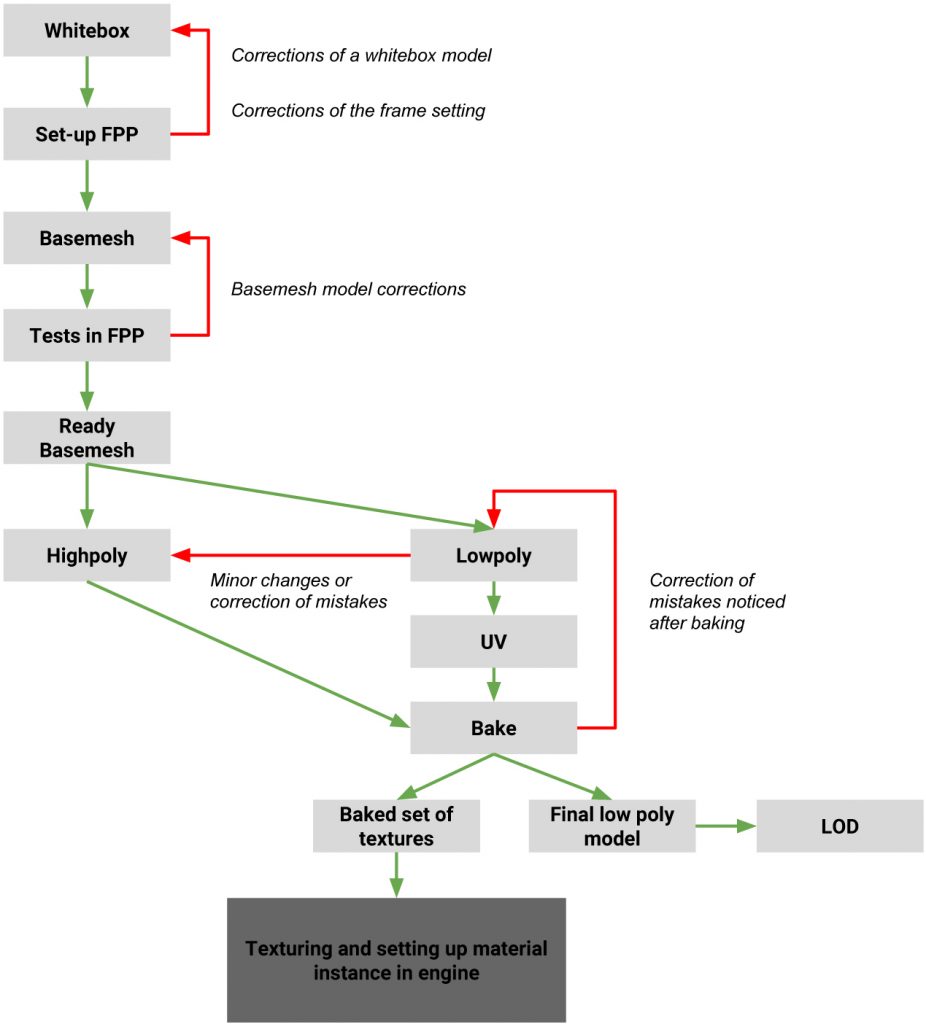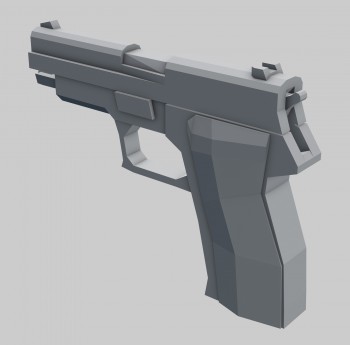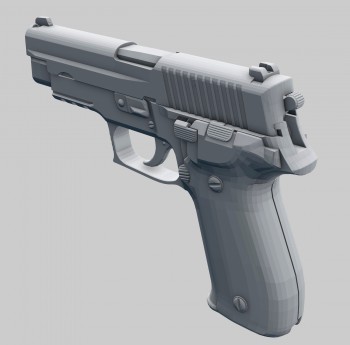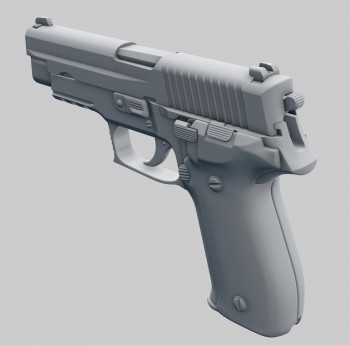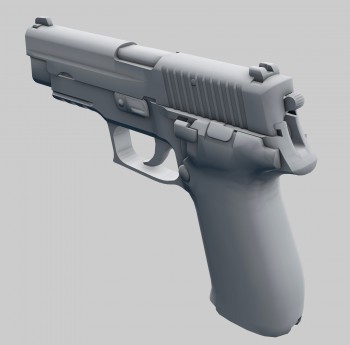1. Charakterystyka widoku FPP
1.0. The first person perspective
Whenever something is created it is important to analyse how the object is going to be presented. This applies to almost every manifestation of human creativity.
The first chapter is entirely devoted to the general issues connected with the FPP view. The first-person perspective (FPP) differs from the others (e.g. a TPP or isometric projection) by the way the camera is embedded in the world of game.
In order to create a correct object in this projection, a knowledge of the object we are modelling is necessary (good analysis of the issue) and a knowledge of the shot which the object will be presented in (the relation of the object to the frame).
The rules for the FPP view are universal, the same for a lighter, a screwdriver or a rocket launcher. An experienced graphic, who knows the character of the FPP view, working on yet another object needs only to „understand” the object that is being created.
1.1. The history of the FPP games
Games with the first person perspective were a breakthrough for the video game industry. Thanks to it, a player
[…] could empathies more with the character he was playing with. source
Together with the technological development, more and more creators turned to the FPP view, most often used it in RPG games […] It wasn’t, however, before the beginning of ’90s when the real breakthrough came: id Software launched Wolfenstein 3D, the game that set the standards. source
But it was
DOOM, launched in 1993, that revolutionized not only the shooter games, but also the whole market of computer games. source
The FPP games can be distinguished by a prop that appears in the screen corner. Usually, though it’s not a rule, a prop is being hold by a player.
source: http://www.gry-online.pl/slownik-gracza-pojecie.asp?ID=67
source: http://www.eurogamer.pl/articles/2014-10-23-40-gier-ktore-napisaly-historie-fps-ow?page=2
source: http://www.eurogamer.pl/articles/2014-10-23-40-gier-ktore-napisaly-historie-fps-ow?page=3
![The Farm 51. <b> Painkiller Hell&Damnation</b> [PC]. Nordic Games, 2012, <i>source: http://www.wsgf.org/dr/painkiller-hell-damnation/en</i>](http://piratportfolio.com/fpp_eng/wp-content/uploads/2015/06/1.1.A_I1.jpg)
![Valve Corporation, Hidden Path Entertainment. <b>Counter-Strike: Global Offensive</b> [PC]. Valve Corporation, 2012, <i>source: https://www.oglasindo.rs/softver/oglas/counter-strike-global-offensive-csgo-9257</i>](http://piratportfolio.com/fpp_eng/wp-content/uploads/2015/06/1.1.A_II-1024x576.jpg)
1.2. The FPP game screenshot
By dividing frames of a FPP game into layers, we can find:
- scene (bright) – the world of game
- character (dark) – hands and props
- GUI (black) – the user interface
In this publication we are interested in the layer concerning the game character. A prop, usually a weapon, included in the frame is something between the world of game and the user interface. Even though a prop:
- is visually coherent with the world of game,
- is affected by the light and post-process,
- is fully a 3D model.
The main task of a prop is to inform a player (similarly to GUI). The object in frame tells what the player has at his disposal.
The Character’s layer can be treated in an autonomous way – it’s unique and specific. An object in this layer should not only „look good” but also fulfil certain principles.
The object and its hands rotate according to the camera rotation (a prop is attached to the camera) which means they are always in the same place in the frame and take up given space.
The character’s layer has its own, independent FOV. Thanks to that both the prop and the world of game can be presented in the most attractive way (in an adjusted and independent perspective). Such an assumption can sometimes contribute to strange situations. The problem, however, is not noticeable by a player.
The object of weapon was initially placed closer to the middle of the screen, with time it moved towards the right side. Such placing has become the standard one. Today it is hard to imagine a FPS with a weapon located on the left. Dual-wield is an exception because on the screen we can see two pieces of weapon, on both sides of the screen.
![Gearbox Software. <b>Borderlands 2</b> [PC]. 2K Games, 2012, <i>source: https://i.ytimg.com/vi/8UQLCWCWYDc/maxresdefault.jpg</i>](http://piratportfolio.com/fpp_eng/wp-content/uploads/2015/06/1.2.C_I-1024x576.jpg)
1.3. Props in a player’s hands
A prop held in a player’s hands can be really everything. From food to everyday-use objects, up to rocket launchers. Most often, however, the prop is a gun.
While categorizing props for a FPP view one can certainly use „actual criteria”, such as melee weapons, firearm, bladed weapon, tools and so on. However, from a graphic point of a view it is better to determine whether the model:
- changes its position in the frame dynamically ‒ usually melee steel or tools. Most often the objects that we can look at carefully from every angle are objects that appear in the cut-scene,
- is more static – it usually concerns firearm, magic artefacts. They can be animated, however, are usually seen from the first person perspective.
By determining it at the very beginning we know which areas of a given object are of particular importance (clearly seen), and which are not.
![Techland. <b>Hellraid</b> [promotional materials]. 2013, <i>source: http://www.gamespot.com/articles/dead-island-dev-s-xbox-one-ps4-pc-co-op-slasher-he/1100-6427508/</i>](http://piratportfolio.com/fpp_eng/wp-content/uploads/2015/06/1.3.A_I-1024x576.jpg)
![EA Los Angeles. <b>Medal of Honor: Airborne</b> [PC]. Electronic Arts, 2007, <i>source: http://filmovizia.blogspot.com/2012/06/medal-of-honor-airborne.html</i>](http://piratportfolio.com/fpp_eng/wp-content/uploads/2015/06/1.3.A_II-1024x640.jpg)
1.4. The process of object creation
Creating an asset together with a texture is a clearly described, multi-staged process. It can differ depending on pipeline, technology and project’s targets. Despite these differences, pipeline usually looks as follows:
While making corrections one needs to go few stages back. In the worst case if we spot an error (e.g. some element is missing) already after texturing, we will have to leave everything behind and come back to the very beginning. This production drawback concerns also cooperation with people responsible for choosing kinds of weapon for a game. Should we fail to receive full information, or they change their vision of a model, we will have to start all over.
A good approach is to think at least one stage ahead. It is also not advisable to decide to whitewash some problems that have already appeared in the stage we are working on in the subsequent one. To gain 100% of quality, each stage needs to be performed on 100% too.
A graphic needs to be aware of the fact that weapon in FPP kind of games is more important that the characters’ faces. After all it is the weapon that we see majority of the time. The aim is not only to get a correct model, but also to make it interesting, pleasing and to give it the necessary features – to bring it to perfection, as close as possible. Each weapon should become a piece of art.
![Bungie. <b>Destiny</b> [PS4]. Activision, 2014](http://piratportfolio.com/fpp_eng/wp-content/uploads/2015/06/1.2.A_I.gif)
![2K Marin, 2K Australia. BioShock 2 [PC]. 2K Games, 2010](http://piratportfolio.com/fpp_eng/wp-content/uploads/2015/06/1.2.b_I-350x197.jpg)
![2K Marin, 2K Australia. BioShock 2 [PC]. 2K Games, 2010](http://piratportfolio.com/fpp_eng/wp-content/uploads/2015/06/1.2.b_II-350x197.jpg)
![RuneStorm. Viscera Cleanup Detail [PC]. RuneStorm, 2015, source: http://www.runestorm.com/blog/2014/07/14/viscera-cleanup-detail-v0-29-unearthly-excavation/](http://piratportfolio.com/fpp_eng/wp-content/uploads/2015/06/1.3.B_I-350x197.jpg)
![Ubisoft Montreal. Far Cry 3 [PC]. Ubisoft, 2012, source: http://www.giantbomb.com/far-cry-3/3030-32933/forums/anybody-else-rocking-a-bow-569599/?page=1#js-message-6186975](http://piratportfolio.com/fpp_eng/wp-content/uploads/2015/06/1.3.B_II-350x197.png)
![4A Games. Metro Last Light [PC]. Deep Silver, 2013](http://piratportfolio.com/fpp_eng/wp-content/uploads/2015/06/1.3.B_VI-350x219.jpg)
![EA DICE. Battlefield 3 [PC]. Electronic Arts, 2011, source: http://www.aed.com/blog/aed-gave-an-average-joe-some-superhero-swagger/](http://piratportfolio.com/fpp_eng/wp-content/uploads/2015/06/1.3.B_V-350x219.jpg)
![People Can Fly, Epic Games. Bulletstorm [PC]. Electronic Arts, 2011](http://piratportfolio.com/fpp_eng/wp-content/uploads/2015/06/2015-12-29_00026-350x197.jpg)
![Irrational Games. BioShock [PC]. 2K Games, 2007](http://piratportfolio.com/fpp_eng/wp-content/uploads/2015/06/1.3.B.IV_-350x197.jpg)
![4A Games. Metro 2033 [PC]. THQ, 2010](http://piratportfolio.com/fpp_eng/wp-content/uploads/2015/06/2012-12-22_00009-350x219.jpg)
![Digital Illusions CE. Battlefield 1942 [PC]. Electronic Arts, 2002, source: http://battlefield.wikia.com/wiki/Hand_grenade](http://piratportfolio.com/fpp_eng/wp-content/uploads/2015/06/1.3.B_III-350x263.png)
